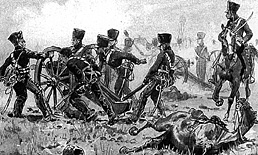 Many artillery officers, when engaging enemy artillery, ordered their battery's fire to be directed along the entire front of the enemy battery. Each artillery piece within their command, in effect, had a different target. General Lallemand, who served with the French Imperial Guard, decried this practice as useless. Although each of the enemy's pieces were inconvenienced, losing several men or horses, it was rare that any were put completely out of service. Unintimidated, the enemy fire continued unabated.
Many artillery officers, when engaging enemy artillery, ordered their battery's fire to be directed along the entire front of the enemy battery. Each artillery piece within their command, in effect, had a different target. General Lallemand, who served with the French Imperial Guard, decried this practice as useless. Although each of the enemy's pieces were inconvenienced, losing several men or horses, it was rare that any were put completely out of service. Unintimidated, the enemy fire continued unabated.
Instead, Lallemand advised the officer commanding the battery to ensure that all the guns within the battery concentrate their fire upon a single target. Then, as soon as the enemy gun was dismounted or destroyed, they were to turn their attention to a new target. Thus enemy guns would be destroyed one at a time, until none remained operative.
The memoirs of General Vionnet Vicomte de Maringone, provide us with a account of the French artillery doing precisely this. Vionnet was the major-commandant of the 1st and 2nd regiments de tirailleurs of the Young Guard. At the combat of Gross-Garten (27 August, 1813), Maringone's brigade was ordered to advance against a village where the enemy had positioned 15 artillery pieces. The enemy battery fired relentlessly, and Maringone was forced to deploy his troops into column and hide them behind some undulating terrain. The general commanding the French division sent 12 artillery pieces to ameliorate the brigade's situation. These were positioned on either side of the column. Maringone ordered the guns to aim at one of the enemy guns which was soon destroyed. This process was continued and after two hours nearly all of the enemy's guns were silenced. Unfortunately for the French, all of this was to little avail, for as soon as the enemy battery was rendered ineffective another battery, this time 20 cannon of larger caliber, took its place, and succeeded in causing more damage than its predecessors.
Occasionally, the officer commanding a battery of light artillery would come under fire from enemy artillery of a heavier caliber. When this happened, the text book approach was to advance the guns as close as possible to the enemy fire, without advancing to within canister range. This would minimize the difference in calibers.
Colonel Serruzier found himself in just a situation at Jena [14 October, 1806]. His battery of four pounders came under the fire of Prussian twelve pounders, six hundred meters distant. This unfortunately was within the enemy battery's canister range, and unless something was done immediately, the French battery faced certain extinction. Serruzier ordered half of his pieces (the even ones) to double their fire. Under the cover of the clouds of smoke thus created, the odd pieces advanced to within point blank range. The enemy was unaware of this movement and continued to fire at the original longer range. The odd pieces now began to fire quickly as the even pieces were moved up in turn. The Prussian battery lost all of its advantages, and further, found itself firing at the wrong range. The French guns, on the other hand, were able to fire extremely accurately, and one by one, the Prussian guns were disabled and the battery destroyed.
More of With Musket, Cannon and Sword
-
Introduction
Battle of Lodi (May 10, 1796)
Battle of Sedyman (October 7, 1798)
Theoretical vs. Practical Musketry
Speed of a Cavalry Attack
Concentrating Counter-Battery Fire
Back to Table of Contents -- Napoleon #2
© Copyright 1996 by Emperor's Press.
This article appears in MagWeb (Magazine Web) on the Internet World Wide Web.
The full text and graphics from other military history magazines and gaming magazines are available at http://www.magweb.com